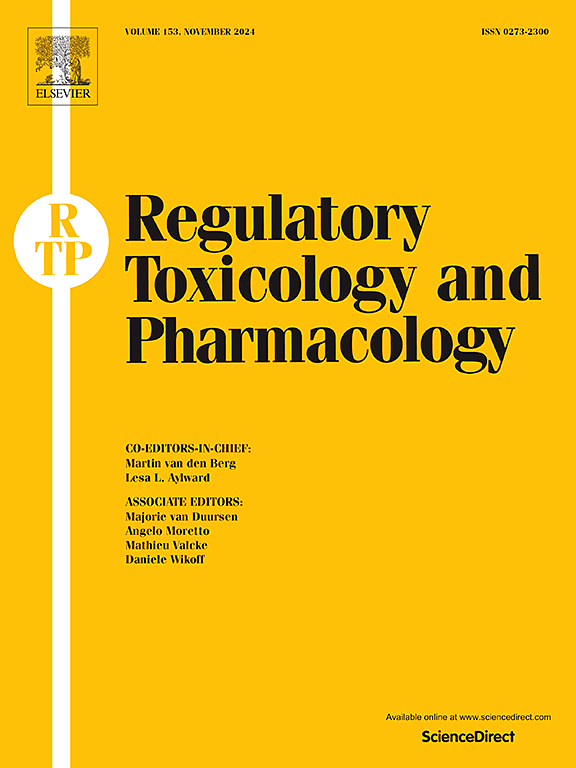Mode of action analysis for mouse liver tumor formation by MGK-264 and human relevance
IF 3.5
4区 医学
Q1 MEDICINE, LEGAL
引用次数: 0
Abstract
MGK-264, an insecticidal synergist, has been shown to increase the incidence of liver tumors in male and female mice. As MGK-264 is not a genotoxic compound, a series of investigative studies were conducted to elucidate the mode of action (MoA) for liver tumor production by MGK-264. Male and female CD-1 mice were given diets containing MGK-264 at 400, 3000, and 6000 ppm for 7 and/or 14 days. Treatment with MGK-264 caused activation of the constitutive androstane receptor (CAR), which resulted in liver hypertrophy, induction of cytochrome P450 CYP2B subfamily enzymes, and increased replicative DNA synthesis (RDS) in the liver in male and female mice. In contrast, these changes were not observed in the livers of male CAR and pregnane X receptor (PXR) knockout (CAR KO/PXR KO) mice treated with MGK-264. The treatment of primary human hepatocytes with 1–30 μM MGK-264 increased CYP2B and CYP3A mRNA expression, but had no effect on hepatocyte RDS. Similarly, the treatment of chimeric mice with human hepatocytes with 6000 ppm MGK-264 in the diet for 7 days resulted in increased CYP2B and CYP3A mRNA expression, but had no significant effect on human hepatocyte RDS. In summary, based on these investigative studies, MGK-264 is a CAR activator at carcinogenic dose levels in mouse liver. A robust MoA for MGK-264-induced mouse liver tumor formation has been established and is not considered plausible for humans on the basis of qualitative differences between humans and mice. This conclusion is supported by data from human epidemiology studies with CAR activators.
MGK-264对小鼠肝肿瘤形成的作用模式分析及其与人的相关性
MGK-264是一种杀虫增效剂,已被证明可增加雄性和雌性小鼠肝脏肿瘤的发生率。由于MGK-264不是一种基因毒性化合物,因此进行了一系列的调查研究来阐明MGK-264对肝脏肿瘤产生的作用模式(MoA)。给雄性和雌性CD-1小鼠喂食含有400ppm、3000ppm和6000ppm的MGK-264的饲料7天和/或14天。MGK-264可激活构成型雄甾受体(CAR),导致肝脏肥大,细胞色素P450 CYP2B亚家族酶的诱导,增加雄性和雌性小鼠肝脏的复制性DNA合成(RDS)。相比之下,在MGK-264处理的雄性CAR和妊娠X受体(PXR)敲除(CAR KO/PXR KO)小鼠的肝脏中没有观察到这些变化。1-30 μM MGK-264处理人原代肝细胞后,CYP2B和CYP3A mRNA表达增加,但对肝细胞RDS无影响。同样,在人肝细胞嵌合小鼠的饮食中添加6000 ppm MGK-264处理7天,CYP2B和CYP3A mRNA表达增加,但对人肝细胞RDS没有显著影响。总之,基于这些调查研究,MGK-264在小鼠肝脏中是一种具有致癌剂量水平的CAR激活剂。已经建立了mgk -264诱导小鼠肝脏肿瘤形成的可靠MoA,但基于人和小鼠之间的质性差异,认为不可能适用于人类。这一结论得到了CAR激活剂人类流行病学研究数据的支持。
本文章由计算机程序翻译,如有差异,请以英文原文为准。
求助全文
约1分钟内获得全文
求助全文
来源期刊
CiteScore
6.70
自引率
8.80%
发文量
147
审稿时长
58 days
期刊介绍:
Regulatory Toxicology and Pharmacology publishes peer reviewed articles that involve the generation, evaluation, and interpretation of experimental animal and human data that are of direct importance and relevance for regulatory authorities with respect to toxicological and pharmacological regulations in society. All peer-reviewed articles that are published should be devoted to improve the protection of human health and environment. Reviews and discussions are welcomed that address legal and/or regulatory decisions with respect to risk assessment and management of toxicological and pharmacological compounds on a scientific basis. It addresses an international readership of scientists, risk assessors and managers, and other professionals active in the field of human and environmental health.
Types of peer-reviewed articles published:
-Original research articles of relevance for regulatory aspects covering aspects including, but not limited to:
1.Factors influencing human sensitivity
2.Exposure science related to risk assessment
3.Alternative toxicological test methods
4.Frameworks for evaluation and integration of data in regulatory evaluations
5.Harmonization across regulatory agencies
6.Read-across methods and evaluations
-Contemporary Reviews on policy related Research issues
-Letters to the Editor
-Guest Editorials (by Invitation)

 求助内容:
求助内容: 应助结果提醒方式:
应助结果提醒方式:


